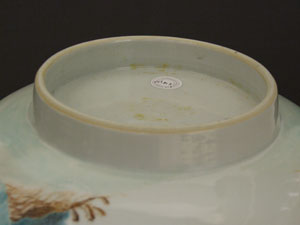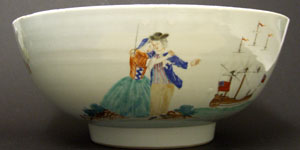
QIANLONG DATED 1757 Chinese Export Porcelain
A Very Rare, Apparently Unrecorded, Inscribed and Dated Chinese Export Porcelain `Sailor`s Farewell` Bowl. The Well of the Bowl is Inscribed `Elizabeth Darling 1757` in Large Gilt Capital Letters. The Exterior Decorated with a Scene of the `Sailor`s Farewell` and the `Sailor`s Return` with Ships Flying the British Flag.
SOLD
- Condition
- Damaged and repaired, a large section broken out and re-stuck, this had previously been riveted c. 165 mm x 100 mm. Two large cracks sealed c. 100 mm and 84 mm. Friting to the rim.
- Size
- Diameter : 28.5 cm (11 1/2 inches)
- Provenance
- N/A
- Stock number
- 21813
- References
- Inscribed Punch Bowls - An unrecorded inscribed Chinese Export Porcelain bowl makes a very useful comparison, it bares the date 1747 next to the name Elizabeth Cook and also that of William Hillyard in gilt. According to family tradition, the commissioner and purchaser of this bowl, William Hillyard, was a navel officer traveling to the Far East, and so he would have been able to commission the unique inscription in Canton. When he returned from the voyage, he discovered that his fiancee Elizabeth had married another suitor, and the only tangible relic therefore of their doomed courtship was this bowl from Canton. The bowl passed to William`s sister and thence by decent along the female side of the family. This extraordinary bowl shows a Western merchant ship including one of it dis-masted, see Fine Chinese Export Porcelain and Works of Art, 15th and 16th of June 1987. For punch-bowl with an gilt inscription to the well within double lines The Haeslingfield in Distress. September 1743 see : China for the West, Chinese Porcelain & other Decorative Arts for Export Illustrated from the Mottahedeh Collection (David S. Howard and John Ayers, Sotheby`s, 1978) Volume 1, page 220, plate 217. Another bowl depicting The Haeslingfield in Distress. September 1743 with the names `James Beech , Fecit` and `John James Jackson, Jan 17, Canton, China, 1744, I.B.` in gilt see : Export Art of China and Japan, The China Trade Sale, Christie`s London, 7th of April 1997, lot 67. The Sailor`s Farewell - For a version of the `The Sailor`s Farewell` design but with a Dutch flag see : China for the West, Chinese Porcelain & other Decorative Arts for Export Illustrated from the Mottahedeh Collection (David S. Howard and John Ayers, Sotheby`s, 1978) Volume 1, page 195, plate 192.
Information
This bowl is probably unique, unlike most inscribed and dated punch bowls the present example does not depict an specific ship, so Elizabeth Darling is far more likely to be that of a woman rather than a ship. It would have been commissioned by a Ships captain or more senior crew member in Canton. Hopefully Elizabeth darling was waiting for him on his return where he would give her some of the riches of his voyage as depicted in the view of the sailors return, unlike the doomed romance on a bowl made for Elizabeth Cook in 1747 (see references).
There are many branches of the Darling family, when this bowl was produced the family had members in Ireland, Scotland, as well as England. Members of Darling family settled in Virginia in 1654 and Boston in 1651. I have contacted the family through their website but they were not able to find an Elizabeth Darling who matched the date of 1757.
The Sailor`s Farewell :
This popular Chinese export pattern was painted in the Famille Rose palette. It was painted in different version from the 1740`s to the 1770`s. The design was customised for different countries, the ships flag could be Danish, Dutch or British. It is worth quoting David Howard, who as normal has thoroughly researched the subject and has concisely explained the design in there different forms in `China for the West` (China for the West, Chinese Porcelain & other Decorative Arts for Export Illustrated from the Mottahedeh Collection, David S. Howard and John Ayers, Sotheby`s, 1978, Volume 1, page 195. "As with the majority of paintings of European vessels at this period the guns are run out as if for action, and this is how the Chinese would have seen ships at Whampoa. The fact that the ship is under way shows that the concept of `The Sailor`s farewell` was lost on the painter. At least four versions of the `The Sailor`s farewell` are known on Chinese porcelain : the earliest, with decoration in the Meissen style, shows a gentleman-captain in a fine coat and knee-breeches comforting a lady who clings to him, usually to his right, while he points with his right hand to his ship... Behind is a castle with domed turrets. The second version shows a `sailor-lad` in trousers, a cane in his right hand, which rests on the shoulder of a country girl to his left who leans her head on his shoulder. This version seems to have been favoured by the British market. The third ... is similar but with an officer and a lady standing to his left - a view favoured by the Dutch". He illustrates a fourth version with classical figures on the follow page, he also mentions the design was copied or faked by Samson in Paris in the late 19th and/or 20th century.
